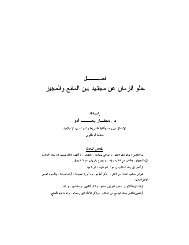Anderson's Winesburg, Ohio: The Individual in the Village Dr ...
Anderson's Winesburg, Ohio: The Individual in the Village Dr ...
Anderson's Winesburg, Ohio: The Individual in the Village Dr ...
Create successful ePaper yourself
Turn your PDF publications into a flip-book with our unique Google optimized e-Paper software.
Damascus University Journal, Vol.٢٠, No. (١+٢), ٢٠٠٤<br />
Kutrieh<br />
Ahmad Ramez<br />
Most of <strong>the</strong> characters of <strong>W<strong>in</strong>esburg</strong> have trouble communicat<strong>in</strong>g<br />
with o<strong>the</strong>rs. Several critics have mentioned <strong>the</strong> fact that <strong>the</strong> characters of<br />
<strong>W<strong>in</strong>esburg</strong> seek out George Willard to tell him <strong>the</strong>ir stories.٥ This<br />
narrative device allows <strong>the</strong> readers to hear <strong>the</strong> <strong>in</strong>ner thoughts of <strong>the</strong><br />
characters as <strong>the</strong>y confide <strong>in</strong> George. S<strong>in</strong>ce George is <strong>the</strong> journalist who<br />
wants to become a writer, it is often assumed that he represents young<br />
Sherwood before leav<strong>in</strong>g his little <strong>Ohio</strong> town for Chicago, as does<br />
George at <strong>the</strong> end of <strong>the</strong> book.٦ George is always roam<strong>in</strong>g <strong>the</strong> streets as<br />
a reporter look<strong>in</strong>g for news to publish <strong>in</strong> <strong>the</strong> town paper. It seems natural<br />
for him to be <strong>the</strong> one to listen to <strong>the</strong> stories of <strong>the</strong> characters. But some<br />
of <strong>the</strong> characters have trouble speak<strong>in</strong>g even to him. Moments of<br />
awkward silence are evident several times <strong>in</strong> several stories.<br />
Elizabeth Willard, George's mo<strong>the</strong>r, is unable to express her wishes<br />
and dreams to her son. In "Mo<strong>the</strong>r," <strong>the</strong> reader is told, "<strong>The</strong> communion<br />
between George Willard and his mo<strong>the</strong>r was outwardly a formal th<strong>in</strong>g<br />
without mean<strong>in</strong>g”(٢٦). "In <strong>the</strong> even<strong>in</strong>g when <strong>the</strong> son sat <strong>in</strong> <strong>the</strong> room with<br />
his mo<strong>the</strong>r, <strong>the</strong> silence made <strong>the</strong>m both feel awkward”(٢٨). When <strong>the</strong>y<br />
talk later <strong>in</strong> <strong>the</strong> story he tells her, "I suppose I can't make you understand,<br />
but oh, I wish I could." When he tells her that he wants to leave<br />
<strong>W<strong>in</strong>esburg</strong>, she wanted to express herself by cry<strong>in</strong>g with joy but could<br />
not accomplish that form of non-verbal communication. Aga<strong>in</strong>, silence<br />
becomes unbearable to her. To manage <strong>the</strong> moment, she sends him<br />
outdoors among <strong>the</strong> boys(٣٧). When she dies, close to <strong>the</strong> end of <strong>the</strong><br />
book, she had not been able to tell him about her hidden money, money<br />
that could improve her son's life and take him away from her husband.<br />
Nilsen Gokcen’s argument <strong>in</strong> his dissertation is that <strong>the</strong> characters of<br />
<strong>W<strong>in</strong>esburg</strong> strive to break <strong>the</strong> barriers between <strong>the</strong>m and o<strong>the</strong>rs but <strong>the</strong>re<br />
is a lack of communication and as a result self-fulfillment is never<br />
completed.<br />
<strong>The</strong> difficulty to communicate faced by <strong>Anderson's</strong> characters<br />
highlights <strong>the</strong> way <strong>the</strong>y relate to <strong>the</strong>ir community. <strong>The</strong>y are separate,<br />
th<strong>in</strong>k differently from o<strong>the</strong>rs, and have <strong>the</strong>ir own separate dreams, a<br />
pattern that has its mark on <strong>the</strong>m all. <strong>The</strong>y match each o<strong>the</strong>r <strong>in</strong> be<strong>in</strong>g out<br />
of harmony with <strong>the</strong> society of <strong>the</strong> Midwestern village. This situation of<br />
<strong>Anderson's</strong> characters would seem even more pronounced if his treatment<br />
of <strong>the</strong>m is compared with that of o<strong>the</strong>r writers' characters who are placed<br />
٤٥

















